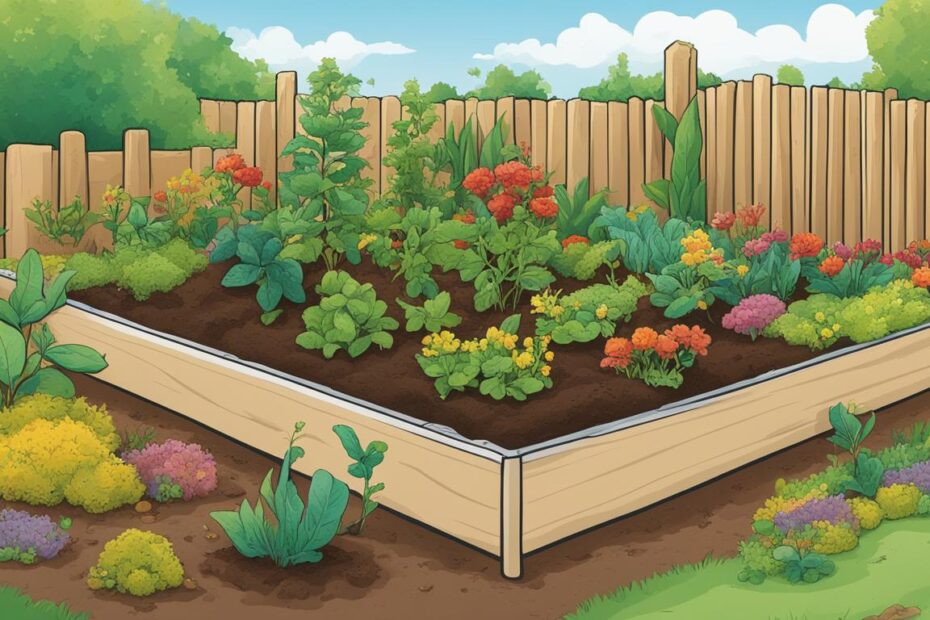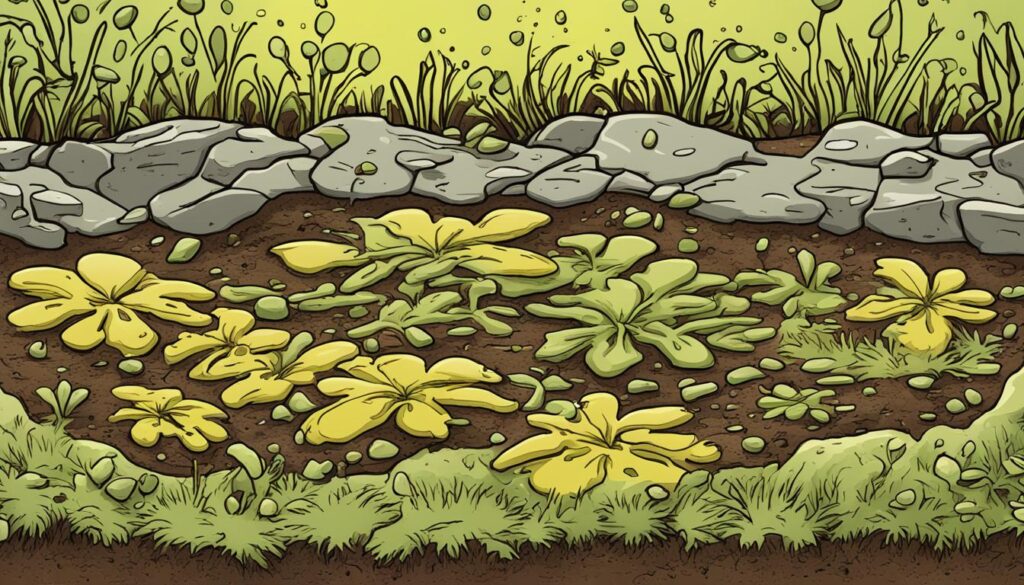Have you ever wondered why some plants thrive while others struggle to survive? The secret lies in the pH of the soil. But here’s the twist – did you know that you have the power to manipulate the pH levels of your soil, and in turn, create the ideal growing conditions for your plants?
From lush green lawns to vibrant flowerbeds, understanding how to raise pH in soil is the key to unlocking the full potential of your garden. By making a few simple adjustments, you can provide your plants with the optimal pH they need to absorb essential nutrients and thrive.
In this article, we’ll explore various methods for increasing soil pH and dive into the factors that affect pH levels. Get ready to unearth the secrets to a healthy garden and discover how you can transform your soil into a haven for flourishing plants.
Key Takeaways:
- Understanding the importance of soil pH in plant health.
- Methods for measuring and adjusting soil pH.
- The role of different materials like lime, baking soda, eggshells, and wood ashes in raising soil pH.
- The influence of soil types, textures, and parent materials on pH levels.
- How to maintain the optimal pH range for specific plants.
Understanding Soil pH and Types
The pH of soil is an essential factor that directly influences plant health and growth. It determines the acidity or alkalinity of the soil and affects the availability of nutrients to plants. Understanding soil pH and its relationship with different soil types is crucial for maintaining a thriving garden.
Soil pH is influenced by the parent materials from which the soil is formed. Soils that develop from basic or alkaline rocks tend to have a higher pH value, while those formed from acidic rocks have a lower pH value. This natural variation in pH can impact the types of plants that can thrive in a particular area.
Rainfall also has a significant effect on soil pH. When water passes through the soil, it can leach alkaline nutrients like calcium and magnesium, leading to increased soil acidity. Additionally, the use of fertilizers containing ammonia or urea and the decomposition of organic matter can contribute to soil acidity over time.
Understanding soil types is also crucial when considering soil pH. Different soil types, such as sandy, loamy, or clay soils, have varying capacities to hold and release nutrients, affecting pH levels. Sandy soils tend to be more acidic, while clay soils tend to be more alkaline. This variation in soil types helps explain why different regions may have different soil pH levels.
Determining the soil texture is equally important in assessing soil pH. Soil texture refers to the proportion of sand, silt, and clay in a particular soil type. The texture affects how water drains through the soil and its ability to retain nutrients, which in turn can impact pH levels.
In summary, understanding soil pH and its relationship with soil types and texture is essential for successful gardening. By knowing the pH of your soil and the specific requirements of the plants you wish to grow, you can make informed decisions about how to adjust soil pH and create an optimal environment for plant growth.
Next, we will delve into different methods to increase soil pH, including the use of lime-based compounds and alternative options like baking soda, eggshells, and wood ashes.
How to Increase Soil pH
If you’re looking to increase the pH in your soil, there are several methods you can use. One of the most common and effective ways is to add lime, which contains calcium and/or magnesium. Lime can help raise the pH and create a more alkaline environment for your plants.
There are different forms of lime that you can choose from, depending on your needs. Dolomite lime, for example, is a popular choice among organic and conventional farmers. It not only increases soil pH but also provides additional magnesium, which is essential for plant growth.
Oyster shell lime is another option that can correct calcium deficiencies while raising pH. This type of lime is a great choice if you have plants that require high levels of calcium.
Agricultural lime, sometimes referred to as aglime, is specifically formulated for agricultural purposes. It can help neutralize acidic soils and improve nutrient availability to promote healthy plant growth.
Hydrated limestone is another lime product that can be used to raise soil pH. It is often more finely ground than other forms of lime, making it easier to mix into the soil.
Baking soda is a gentle and cost-effective method for increasing soil pH. It can be applied directly to the soil and is a good option for smaller gardens or potted plants.
Dried and pulverized eggshells can also be used to raise pH in soil. Eggshells contain calcium carbonate, which can help neutralize acidic soil and provide additional nutrients to plants.
If you have access to wood ashes, they can be a valuable resource for increasing soil pH. Wood ashes contain potassium and calcium carbonate, which can help raise pH levels and provide nutrients for plant growth.
Remember to follow the manufacturer’s dosing instructions when using lime products or other materials to increase soil pH. It is important to avoid overdosing the soil, as this can have negative effects on plant health.
To summarize, here are some methods to increase soil pH:
- Use lime, such as dolomite lime, oyster shell lime, agricultural lime, or hydrated limestone
- Apply baking soda
- Add dried and pulverized eggshells
- Utilize wood ashes
| Lime Type | Benefits |
|---|---|
| Dolomite lime | Increases pH and provides magnesium |
| Oyster shell lime | Corrects calcium deficiencies and raises pH |
| Agricultural lime | Neutralizes acidic soil and improves nutrient availability |
| Hydrated limestone | Finely ground lime that can be easily mixed into soil |

The image above demonstrates the importance of maintaining the right pH for optimal plant growth.
CLICK HERE TO CHECK OUR RECOMMENDED PRODUCTSHow to Decrease Soil pH
In some cases, it may be necessary to decrease the pH of the soil, especially for plants that thrive in acidic conditions. Two common methods for decreasing soil pH are using aluminum sulfate and sulfur. Aluminum sulfate can rapidly decrease the pH when it dissolves in the soil, while sulfur takes time to convert to sulfuric acid with the help of soil bacteria. Aluminum sulfate is generally the preferred option due to its faster reaction time.
It is important to work these materials into the soil and avoid contact with plant leaves to prevent leaf burn. Applying these materials should be done with caution and in accordance with recommended rates to avoid potential harm to plants.
Comparison of Aluminum Sulfate and Sulfur for Decreasing Soil pH
| Method | Reaction Time | Application Guidelines |
|---|---|---|
| Aluminum Sulfate | Rapid | Work into the soil and avoid contact with plant leaves. Apply according to recommended rates. |
| Sulfur | Takes time to convert to sulfuric acid | Work into the soil and allow time for conversion. Apply according to recommended rates. |
Factors Affecting Soil pH and Nutrient Availability
The pH value of soil plays a crucial role in determining the availability of nutrients for plants. Different plants have varying preferences for soil pH, with some thriving in acidic soils while others requiring more alkaline conditions. Extreme pH levels can significantly impact plant growth by influencing nutrient availability and even increasing the toxicity of certain minerals.
Acidic soils can have detrimental effects on plants. This type of soil can make aluminum and manganese more readily available and toxic to plants, leading to stunted growth and nutrient deficiencies. On the other hand, alkaline soils can limit the availability of essential nutrients like phosphorus and micronutrients, hindering plant development.
To ensure healthy plant growth and prevent nutrient deficiencies, it is crucial to maintain the optimal pH range for the specific plants you are growing. This involves understanding the primary and secondary nutrients that are affected by soil pH.
Primary Nutrients
The primary nutrients that are crucial for plant growth are nitrogen, phosphorus, and potassium. These nutrients are essential for various plant functions, such as promoting leaf and stem growth, enabling root development, and supporting overall plant vigor. The availability of these primary nutrients is directly influenced by soil pH.
Secondary Nutrients
In addition to primary nutrients, secondary nutrients also play a vital role in plant growth. Calcium, magnesium, and sulfur are considered secondary nutrients necessary for healthy plants. These nutrients support various plant functions, including the formation and stability of cell walls, enzyme activation, and protein synthesis. Like primary nutrients, the availability of these secondary nutrients is affected by soil pH.
Understanding these factors and their impact on soil pH and nutrient availability is essential for successful gardening and plant care. A balanced soil pH ensures that plants have access to the necessary nutrients they need to thrive and grow optimally.
| Nutrient | Effect of Acidic Soils | Effect of Alkaline Soils |
|---|---|---|
| Nitrogen (N) | Increased leaching, reduced availability | Reduced availability |
| Phosphorus (P) | Reduced availability | Reduced availability |
| Potassium (K) | Reduced availability | Reduced availability |
| Calcium (Ca) | Reduced availability | Increased availability |
| Magnesium (Mg) | Reduced availability | Increased availability |
| Sulfur (S) | Reduced availability | Increased availability |
In summary, maintaining the right soil pH for your plants is crucial to ensure they have access to the necessary nutrients for optimal growth. Understanding how soil pH affects nutrient availability, particularly for primary and secondary nutrients, allows you to provide the ideal conditions for your plants to thrive and flourish.
CLICK HERE TO CHECK OUR RECOMMENDED PRODUCTSConclusion
Understanding how to raise the pH in soil is crucial for maintaining a healthy garden and promoting optimal plant growth. By correcting the pH, you can ensure that your plants have access to the necessary nutrients they need to thrive. There are various methods you can employ to increase soil pH, including using lime-based compounds like dolomite lime and agricultural lime, as well as alternative options like baking soda, eggshells, and wood ashes.
When raising pH, it’s important to consider factors like soil type, texture, and the specific pH requirements of the plants you are growing. Conducting regular soil testing can help you monitor pH levels and make any necessary adjustments. Remember that different plants thrive in different pH ranges, so understanding their specific needs will help you provide them with the ideal growing conditions.
By taking the time to address soil pH and provide the necessary adjustments, you can ensure that your garden thrives and your plants receive the essential nutrients for optimal health and growth. So, don’t neglect the importance of raising pH in soil and create the perfect environment for your plants to flourish.
FAQ
Why is soil pH important for plant health?
Soil pH is important for plant health because it affects nutrient availability. Plants require specific pH levels to absorb nutrients effectively.
What is the optimal pH level for most plants?
Most plants thrive in a pH level between 6.0 and 7.5, but it is important to research the specific pH requirements for the plants you are growing.
How can I test the pH of my soil?
You can test the pH of your soil using a soil testing kit or by sending a sample to a professional lab for analysis.
How can I increase the pH of my soil?
To increase the pH of your soil, you can use materials that contain lime, such as dolomite lime, oyster shell lime, agricultural lime, or hydrated limestone. Baking soda, eggshells, and wood ashes are also effective options.
Can I decrease the pH of my soil?
Yes, if you need to decrease the pH of your soil, you can use materials like aluminum sulfate or sulfur.
How do soil types and textures affect pH?
Soil types and textures can influence pH levels. Soils formed from basic/alkaline rocks usually have a higher pH value, while acidic rocks can lead to lower pH levels. Additionally, certain soil textures may hold onto nutrients differently, affecting pH levels.
What can happen if the pH level is too low or too high?
Extreme pH levels can impact plant growth by affecting nutrient availability and increasing the toxicity of certain minerals. Acidic soils can make aluminum and manganese more available and toxic to plants, while alkaline soils can reduce the availability of phosphorus and micronutrients.
Should I consider the specific needs of my plants when adjusting soil pH?
Yes, it is crucial to consider the specific pH requirements of the plants you are growing when adjusting soil pH. Different plants thrive in different pH ranges.
How often should I test my soil pH?
It is recommended to test your soil pH regularly, especially if you notice any changes in plant health or growth. Testing annually or every few years is generally sufficient.

